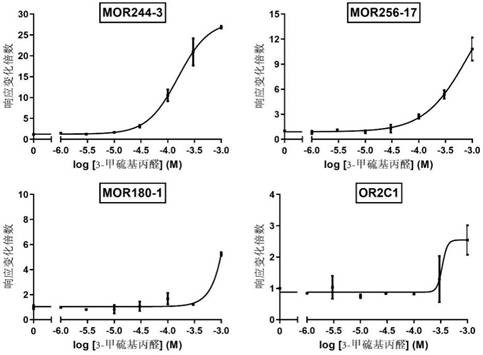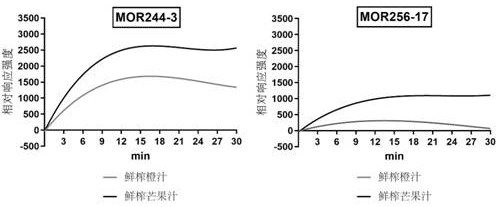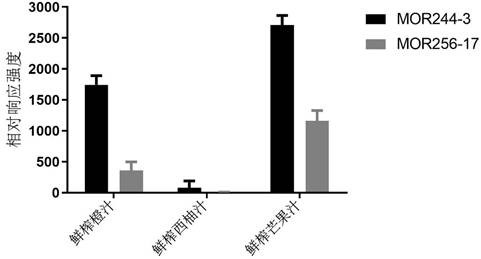Application of olfactory receptor in identification of 3-methylthio-propionaldehyde and method for detecting 3-methylthio-propionaldehyde
A technology of methylthiopropionaldehyde and olfactory receptors, which is applied to the use of olfactory receptors in recognizing 3-methylthiopropionaldehyde and the field of detection of 3-methylthiopropionaldehyde, which can solve the problem that 3-methylthiopropanal has not yet appeared. Propionaldehyde, etc.
- Summary
- Abstract
- Description
- Claims
- Application Information
AI Technical Summary
Problems solved by technology
Method used
Image
Examples
Embodiment 1
[0077] Example 1: Screening of olfactory receptors
[0078] In this example, the dual-luciferase method (Dual-Glo™ Luciferase Assay System, Promega) was used to measure the activity of olfactory receptors. The inventors selected some olfactory receptors from human and mouse olfactory receptor libraries, then prepared gene constructs containing olfactory receptors, Golf, CRE-Luciferase and pRL-SV40, and used the transfection reagent Lipofectamine2000 (Invitrogen) to transfer the olfactory receptors. The gene constructs were transfected into HEK293T cells. After culturing for 24 hours, 3-methylthiopropanal was diluted with culture medium to a concentration of 500 μM, cells were stimulated with the diluted 3-methylthiopropanal, and incubated for 2-4 hours. If the olfactory receptor is activated, the intracellular cAMP concentration increases, cAMP will bind to the promoter region of CRE-luciferase, and promote the transcription and translation of luciferase. By detecting the act...
Embodiment 2
[0088] Example 2: Response of four olfactory receptors to different compounds
[0089] In this example, the method of Example 1 was used to detect the responses of MOR244-3, MOR256-17, MOR180-1 and OR2C1 to three structural analogs of 3-methylthiopropanal (also known as "odor molecules"), The three structural analogs of 3-methylthiopropanal (methional) are 3-methylthiopropanol (methionol), n-pentanal (pentanal) and pentanol (pentanol), the specific test results are shown in Table 1 . Among them, the hydroxyl group in 3-methylthiopropanol replaces the aldehyde group of 3-methylthiopropanal; the carbon atom in n-pentanal replaces the sulfur atom of 3-methylthiopropanal; the hydroxyl and carbon atoms in pentanol At the same time, the aldehyde group and sulfur atom of 3-methylthiopropanal were replaced. In the table, "+++" means the response change fold ≥ 10, "++" means the response change fold 5<X<10 (X is the detected Response change fold), "+" means response change fold ≤ 5, ...
Embodiment 3
[0092] Example 3: Detection of 3-methylthiopropanal in different freshly squeezed fruit juices by MOR244-3 and MOR256-17
[0093] For the detection method in this example, refer to Example 1. The only difference is that in this example, a luciferase variant is used to replace the original dual luciferase, and the olfactory receptors expressing MOR244-3 and MOR256-17 are used respectively. The presence of 3-methylthiopropanal in freshly squeezed orange juice and freshly squeezed mango juice was detected by the cells of the body. For the specific test results, see figure 2 . The results show a peak around 15 minutes (min) with strong signals from both olfactory receptors.
[0094] Cells were pre-expressed with a luciferase variant by co-transfection of the pGloSensor-20F cAMP (Promega) construct. After activation of olfactory receptors, an increase in cAMP concentration can cause a conformational change of luciferase variants, which converts luciferase from an inactive state ...
PUM
| Property | Measurement | Unit |
|---|---|---|
| Sensitivity | aaaaa | aaaaa |
Abstract
Description
Claims
Application Information
 Login to View More
Login to View More - R&D
- Intellectual Property
- Life Sciences
- Materials
- Tech Scout
- Unparalleled Data Quality
- Higher Quality Content
- 60% Fewer Hallucinations
Browse by: Latest US Patents, China's latest patents, Technical Efficacy Thesaurus, Application Domain, Technology Topic, Popular Technical Reports.
© 2025 PatSnap. All rights reserved.Legal|Privacy policy|Modern Slavery Act Transparency Statement|Sitemap|About US| Contact US: help@patsnap.com



